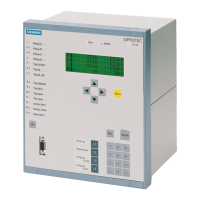Mounting and Commissioning
3.3 Commissioning
SIPROTEC, 7SD610, Manual
C53000-G1176-C145-6, Release date 02.2011
318
3.3.10 Testing User-defined Functions
The device has a vast capability for allowing functions to be defined by the user, especially with the CFC logic.
Any special function or logic added to the device must be checked.
A general procedure cannot in the nature of things be specified. Configuration of these functions and the set
value conditions must be actually known beforehand and tested. Especially, possible interlocking conditions of
the switching devices (circuit breakers, isolators, grounding electrodes) must be observed and checked.
3.3.11 Trip and Close Test with the Circuit Breaker
The circuit breaker and tripping circuits can be conveniently tested by the device 7SD610.
The procedure is described in detail in the SIPROTEC 4 System Description.
If the check does not produce the expected results, the cause may be established from the text in the display
of the device or the PC. If necessary, the connections of the circuit breaker auxiliary contacts must be checked:
It must be noted that the binary inputs used for the circuit breaker auxiliary contacts must be assigned sepa-
rately for the CB test. This means it is not sufficient that the auxiliary contacts are allocated to the binary inputs
No. 351 to 353, 379 and 380 (according to the possibilities of the auxiliary contacts); additionally, the corre-
sponding No. 366 to 368 or 410 and/or 411 must be allocated (according to the possibilities of the auxiliary con-
tacts). In the CB test only the latter ones are analyzed. See also Section 2.16.2. Furthermore, the ready state
of the circuit breaker for the CB test must be indicated to the binary input with No. 371.
3.3.12 Trip / Close Tests for the Configured Operating Devices
Control by Local Command
If the configured operating devices were not switched sufficiently in the hardware test already described, all
configured switching devices must be switched on and off from the device via the integrated control element.
The feedback information of the circuit breaker position injected via binary inputs must then be read out at the
device and compared with the actual breaker position.
The switching procedure is described in the SIPROTEC 4 System Description. The switching authority must
be set in correspondence with the source of commands used. With the switching mode, you can choose
between locked and unlocked switching. In this case, you must be aware that unlocked switching is a safety
risk.
Switching from a Remote Control Centre
If the device is connected to a remote substation via a system (SCADA) interface, the corresponding switching
tests may also be checked from the substation. Please also take into consideration that the switching authority
is set in correspondence with the source of commands used.
